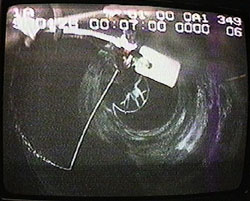
|

|
|
|
©
Per Olof Hulth
|
|
|
Eighteen
hours after the deployment began, the camera is at 2360
meters. The walls begin to close in on the module as the
water in the column refreezes.
|
|
|
|

A
literary essay about AMANDA by Francis Halzen
page 9
The
bubbles were the real problem, however. A kilometer beneath
the surface, we had been told, there would be just a few bubbles,
and those would be no more than a micron in diameter. Instead,
bubbles were everywhere, and they were fifty times larger
than predicted. (We later found a paper on bubbles in ice
cores that corroborated our results. But I suspect that some
glaciologists still do not believe us.) After a good deal
of data analysis and modeling, we predicted that the bubbles
would disappear below 1,400 meters. But though we were eventually
proved right, we had lost a year by then and still had to
go back to drill some new holes.
THIS PAST SUMMER, the second phase of AMANDA was finally calibrated
and the third phase was begun. Our telescope is now made up
of 420 photomultipliers on thirteen separate strands, sunk
between 1,500 and 2,000 meters beneath the Antarctic ice.
The photomultipliers are working without a hitch, the telemetry
data from the drill and in situ laser measurements agree on
their architecture, and the telescope is detecting neutrinos.
If the project as a whole has been a roller-coaster ride—one
so exciting that we often failed to notice when we were hitting
bottom—we are now, undeniably, at a peak. After years
of being consumed by engineering problems, we can now at least
concentrate on physics. Within days of calibrating the telescope,
the intercontinental E-mails that buzz between us changed
topics from scattering angle and photomultiplier noise to
dark matter, gamma-ray bursts and neutrino oscillations.
Although we have yet to mine three-quarters of our data, we
have already begun to follow some veins of interesting science.
Theorists have speculated for a decade or so, for instance,
that the dark matter in the universe is made up of supersymmetric
particles known as neutralinos. According to that theory,
most neutralinos are trapped at the centers of stars and planets,
where standard instruments cannot detect them. When neutralinos
collide at the center of the earth, however, they ought to
generate high-energy neutrinos, which AMANDA can detect.
Early on, an investigator in our Stockholm group noted that
a muon had skittered up one of AMANDA’s strings, illuminating
the photomultipliers in sequence like a string of Christmas
lights. Of all the neutrinos that had streamed through AMANDA
from known cosmic sources, we calculated that only three neutrinos
should have aligned randomly with the center of the earth.
Yet when we looked at our data, we tentatively identified
nine such events. Unfortunately, when we went back over the
numbers, the discrepancy between the number of predicted and
observed events largely evaporated.
|
